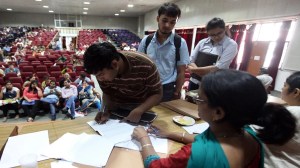- India
- International
Climbing the beanstalk
Budget 2014 talked of developing career centres. We need to make them work
 The new centres must have comprehensive information on a variety of career choices and skill-acquisition opportunities of different kinds.
The new centres must have comprehensive information on a variety of career choices and skill-acquisition opportunities of different kinds.
By: Anirudh Krishna
Tucked between the tax breaks and FDI declarations in the Narendra Modi government’s inaugural budget sits a nugget of a new programme announcement: Rs 100 crore to develop career centres by upgrading employment exchanges, especially in traditionally underserved communities. I have previously made the case for information institutions where young people could reliably procure information on job opportunities, get customised career guidance and meet inspiring role models. Based on thousands of interviews, I had found that young people from poorer communities, no matter how capable and hardworking, were not able to win higher-paying jobs. Those who have recently become engineers, business managers and civil servants are the children of parents who are themselves highly educated and employed in high positions.
This gives rise to a dynamic of layered development — different strata moving forward at different speeds. There are households in India that get by at levels below Rs 5,000 per month. There are others that live global middle-class lifestyles, not very different from their counterparts in other and richer societies. And then there are a series of layers in between.
Problems arise because these layers are growing at different rates, with higher and richer layers growing faster than lower and poorer ones, resulting in rising inequality. The bigger problem arises because these layers are growing increasingly apart from one another. There is very little movement of people from lower to higher layers. My examination of more than 20,000 households in four states showed that while many people have escaped poverty, most have become the near-poor. They live just a little distance above the poverty line, only a handful have become secure; none are rich.
Bumping up the scope of self-improvement is essential. Why do poor youth not manage to secure bigger career achievements? Lack of information is critical to the potential going under-utilised. People growing up in poor communities do not know about career opportunities simply because no one from their community has ever achieved any such career. What children in poor communities lack most is knowledge of alternative careers, how to prepare for them. Children in richer communities have it in abundance and take for granted a cousin writing the IAS entrance exam, a family friend who flies Mirages for the air force. These examples illuminate the career road for a young person in a richer community. In a poorer community, this road is mostly dark; a school teacher here, a police constable there are the only examples. A vicious cycle links underachievement with lack of information.

Career centres can fill such information gaps. Informing, guiding and motivating young people from poorer communities will help talented ones climb higher, crossing from lower to higher layers, an achievement previously denied.
While the logic to support career centres is strong, how these should be staffed and programmed remains to be discovered. The new centres must have comprehensive information on a variety of career choices and skill-acquisition opportunities of different kinds. They must be staffed by professionals trained in career counselling, people who realise that poverty and potential are unrelated. We need sensitive counsellors providing customised advice.
Rs 100 crore is not a princely sum in a country of India’s size but strategically used, it can help develop working models. The need of the day is policy experimentation. Let us encourage states to compete for the pot by developing an innovative plan for one centre and carrying out this plan successfully for a number of years. Let a dozen such experimental career centres (of different models) be implemented simultaneously, and let us observe the results each year for five years. There should be only one criterion for success: how many individuals were able to climb up layers because of your efforts? How many poor kids did you help gain admission to professional colleges and civil service positions? Different modes of engagement should emerge as a result of announcing a competition for the best few models to be initially funded. Some models may be organised in public-private partnership and with CSR funds, some may be run by NGOs, and some managed by government. Different ways of doing things must be tried out and their results assessed.
The dumbest thing would be for the Central government to pick and nominate locations or to apportion the money among state governments without any action plans. The next dumbest thing would be to prescribe a standardised template. There is too little knowledge available. We must first learn — relatively cheaply — what works at the local level, before implementing over a broader region.
Modi’s career centres have to be carefully launched, and the potential is vast. Helping people climb layers is timely and necessary. Equality of outcomes is usually an idealist’s dream, but equality of opportunity is the bedrock of political order and social cohesion.
The writer is a professor and associate dean of international academic programmes at the Sanford School of Public Policy, Duke University
express@expressindia.com
EXPRESS OPINION
More Explained
Apr 24: Latest News
- 01
- 02
- 03
- 04
- 05









































